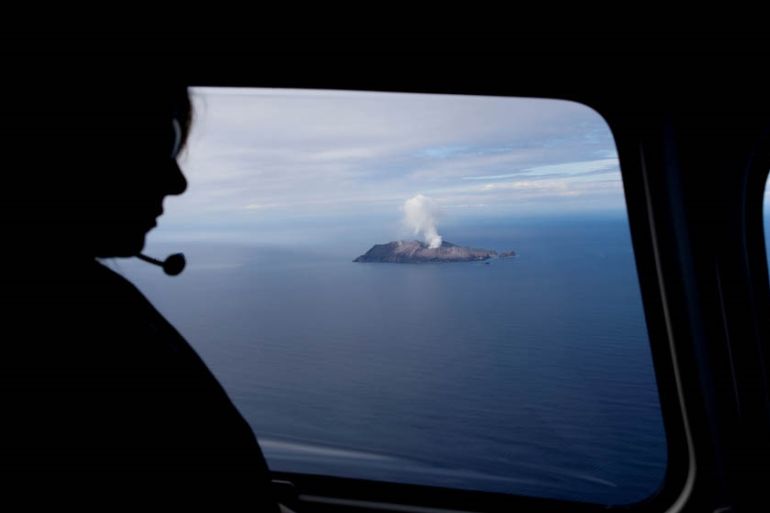New Zealand begins body recovery mission after volcanic eruption
An eight-person team will wear protective clothing and breathing apparatuses during the search-and-recovery mission.

New Zealand police and military specialists have launched a perilous dawn mission to recover bodies from a volcanic island amid fears it might erupt again.
Two New Zealand Defence Force military helicopters set off from the township of Whakatane at first light on Friday bound for Whakaari, the volcano off the North Island where an eruption on Monday is believed to have resulted in at least 16 deaths.
Keep reading
list of 3 itemsIncreased activity on New Zealand’s Whakaari stymies recovery
White Island volcano: All you need to know
At the same time, police took grieving families out near the island on a boat and a Maori blessing was performed.
Authorities say eight bodies remain on the volcano and – after coming under pressure from distraught families – approved a recovery mission despite a 50 to 60 percent chance the volcano – also known as White Island – will explode again in the next day or so.
From a ship based just off the island, volcanologists will monitor live feeds of seismic activity from the still-smouldering volcano as the eight-strong military team attempt to extract the bodies, ready to call off the operation if signs point to another eruption.
‘A lot has to go right for this to work’
The recovery team will wear protective clothing and use breathing apparatuses to try to retrieve the bodies. Scientists have warned that gases on the island after Monday’s eruption are so toxic and corrosive that a single inhalation could be fatal.
“Of course, I’m worried, I would be inhuman if I did not worry,” Deputy Police Commissioner Mike Clement said when he outlined the plan late on Thursday, adding “we have a job to do.”
Clement said the success of the operation would depend on many factors beyond the control of the recovery team, like “the mountain itself, the volcano, the weather and other matters, environmental factors that we don’t control.”
“A lot has to go right for this to work,” he said. “We will all be waiting tomorrow morning to ensure that the people who are putting themselves in harm’s way in the interests of recovering those bodies, our thoughts and our prayers and our love will be with them.”
With the help of drone flights and helicopter pilots who were near the volcano immediately after the eruption, authorities have located six of the eight bodies on the island.
The plan is to immediately recover the six bodies and search for the other two, then transport them to military frigate HMNZS Wellington anchored off the coast, Clement said.
The operation is expected to take several hours.
A further eruption?
New Zealand medical staff were working around the clock to treat the injured survivors in hospital burn units, and specialist medical teams are due to arrive from Australia, the United Kingdom and the United States.
The enormity of the task was clear when Dr Peter Watson, a chief medical officer, said at a news conference that extra skin has been ordered from US skin banks. Hospital personnel anticipated needing an extra 120 square metres (1,300 square feet) of skin for grafting onto patients, Watson said.
Whakaari is the tip of a mostly-underwater volcano that is about 50 kilometres (30 miles) off New Zealand’s North Island and has been a popular attraction visited by thousands of tourists each year.
Authorities say 24 Australians, nine US citizens, five New Zealanders, four Germans, two Britons, two Chinese and a Malaysian were visiting the island on Monday at the time of the eruption. Many were from a Royal Caribbean cruise ship that had left Sydney two days earlier.
New Zealand Prime Minister Jacinda Ardern said on Thursday that some injured Australians had been medically evacuated and such flights would continue. Australia previously said up to 10 such patients would be transferred to hospitals in Victoria and New South Wales states for further treatment.
New Zealand’s GeoNet seismic monitoring agency on Thursday lowered Whakaari‘s volcanic alert level to 2, noting there had been no further eruption since Monday, when the level had briefly been raised to 4. Its alert level since late Monday had been 3 on a scale where 5 signifies a major eruption.
A further eruption in the next day still remains a possibility, the agency said, noting volcanic tremors are rising and steam and mud were being vented regularly.